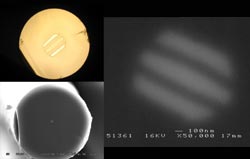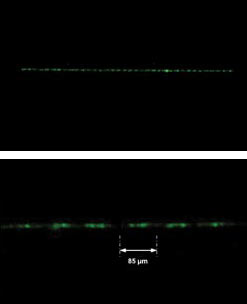Glass “sandwich” creates anisotropic condition that optimizes birefringence.
Breck Hitz, Senior Technical Editor
At the University of Bath in the UK, researchers have produced an optical fiber that they believe has the highest birefringence ever reported. Birefringent fibers are important in applications where the polarization of light that is traveling through the fiber must be maintained, because regular, nonbifringent fibers scramble the polarizations.

Figure 1. The preform consisted of layers of SF 6 and LLF 1 glasses at the center, surrounded by a jacket of LLF 1 (top left). The fiber drawn from the preform had a 60-μm outer diameter and a core diameter of 1.2 μm (bottom left). The three layers of SF 6 are visible in the image created by backscattered electrons (right).
The experimental fiber has a layered core that is composed of two types of glass (Figure 1). The scientists fabricated the unusual fiber by making a triple-decker sandwich from 21 × 50-mm plates of glass: three layers of Schott SF 6 alternated between four plates of Schott LLF 1. They fused the plates, which have similar thermomechanical properties, in a 650 °C oven for three hours, then ground the resulting layered-glass block into a cylindrical rod. They drew this preform down to a diameter of about 1 mm in a drawing tower, jacketed it with a layer of LLF 1 glass that serves as the cladding, and then drew the whole assembly down to the 50-μm diameter of the final fiber.
Although both LLF 1 and SF 6 glasses have an intrinsic loss of about 1 dB/m, the measured loss of the new fiber was ~10 dB/m. The researchers attribute the loss to contamination of the core during the growth process.
Just as two acoustic waves interfere to create a beat note, light scattered from the two polarization waves in a birefringent fiber interferes constructively at a regular interval. This interval, known as the beat distance, can be measured by observing the light scattered sideways from the fiber (Figure 2).

Figure 2. The beat length in the fiber, seen here in the intensity of light scattered from the fiber, was approximately 85 μm at a wavelength of 543 nm.
The investigators measured the beat distance in their fiber at 85 μm for 543-nm light, from which they calculated the phase-index birefringence to be 6.4 × 10–3. They believe that this is the largest birefringence ever reported in an optical fiber.
They also measured the differential group delay in a piece of fiber 80 mm long by low coherence interferometry, determining it to be about 29.3 ps/m at 1540 nm, corresponding to a group-index birefringence of 8.8 × 10–3.
Using the optical-propagation program BeamProp from RSoft Design Group Inc. of Ossining, N.Y., the researchers calculated the expected birefringence for their fiber, given the bulk refractive indices of SF 6 and LLF 1 (1.79 and 1.54, respectively). The yielded value of 1.8 × 10–2 was roughly three times the observed value. They surmised that the discrepancy could be a result of the diffusion of the two glasses during the drawing process. Only a small change in the refractive indices (e.g., from a ratio of 1.54:1.79 to a ratio of 1.59:1.74) would account for the observed birefringence.
An energy dispersive x-ray analysis of the fiber showed evidence of diffusion in the preform, but the system that they used lacked the spatial resolution to examine the fiber itself. Nonetheless, the researchers believe that diffusion is the cause of the discrepancy. When they repeated their calculation with an index ratio of 1.59:1.74, their predicted results for phase-index and group-index dispersion were in excellent agreement with experimental results.
Optics Express, Aug. 8, 2005, pp. 5988-5993.